CRI30010: Youth Justice and Crime - Theories of Juvenile Offending
VerifiedAdded on 2023/04/19
|9
|1010
|74
Presentation
AI Summary
This presentation delves into several key theories of juvenile offending, including social-cognitive theory, rational choice theory, social control theory, labeling theory, and social disorganization theory, alongside Differential Social support and Coercion (DSSC) Theory – General Strain and Self-Control Theory. It examines the core arguments, empirical evidence, and limitations of each theory, providing a comprehensive overview of how these perspectives explain and address youth crime. The presentation also touches upon the juvenile justice system, offering a multifaceted understanding of the causes and consequences of juvenile delinquency. The content is a student's work and is available on Desklib, a platform offering AI-based study tools and resources like past papers and assignments for students.
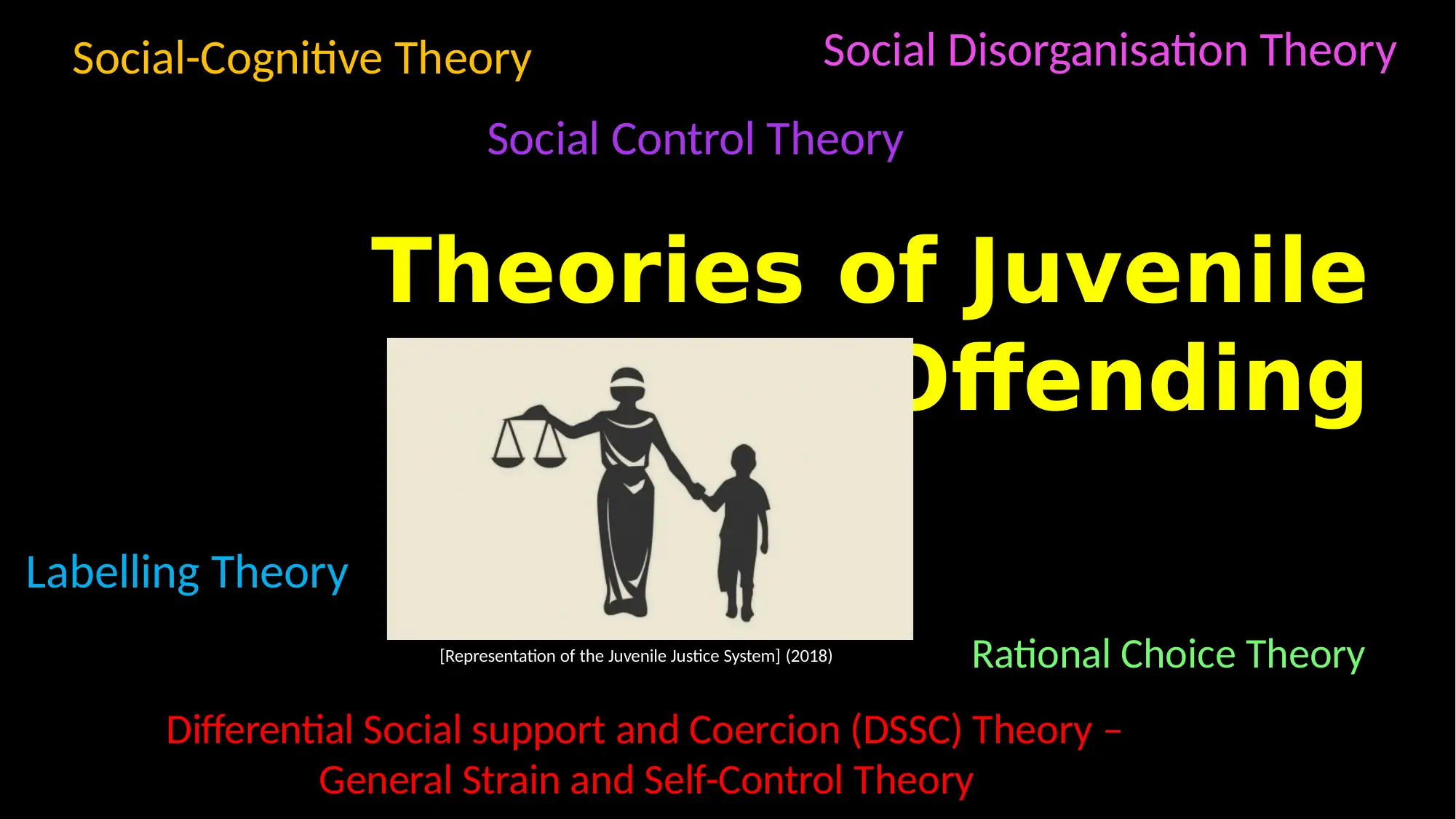
Social-Cognitive Theory
Differential Social support and Coercion (DSSC) Theory –
General Strain and Self-Control Theory
Social Control Theory
Theories of Juvenile
Offending
Labelling Theory
Rational Choice Theory
Social Disorganisation Theory
[Representation of the Juvenile Justice System] (2018)
Differential Social support and Coercion (DSSC) Theory –
General Strain and Self-Control Theory
Social Control Theory
Theories of Juvenile
Offending
Labelling Theory
Rational Choice Theory
Social Disorganisation Theory
[Representation of the Juvenile Justice System] (2018)
Paraphrase This Document
Need a fresh take? Get an instant paraphrase of this document with our AI Paraphraser
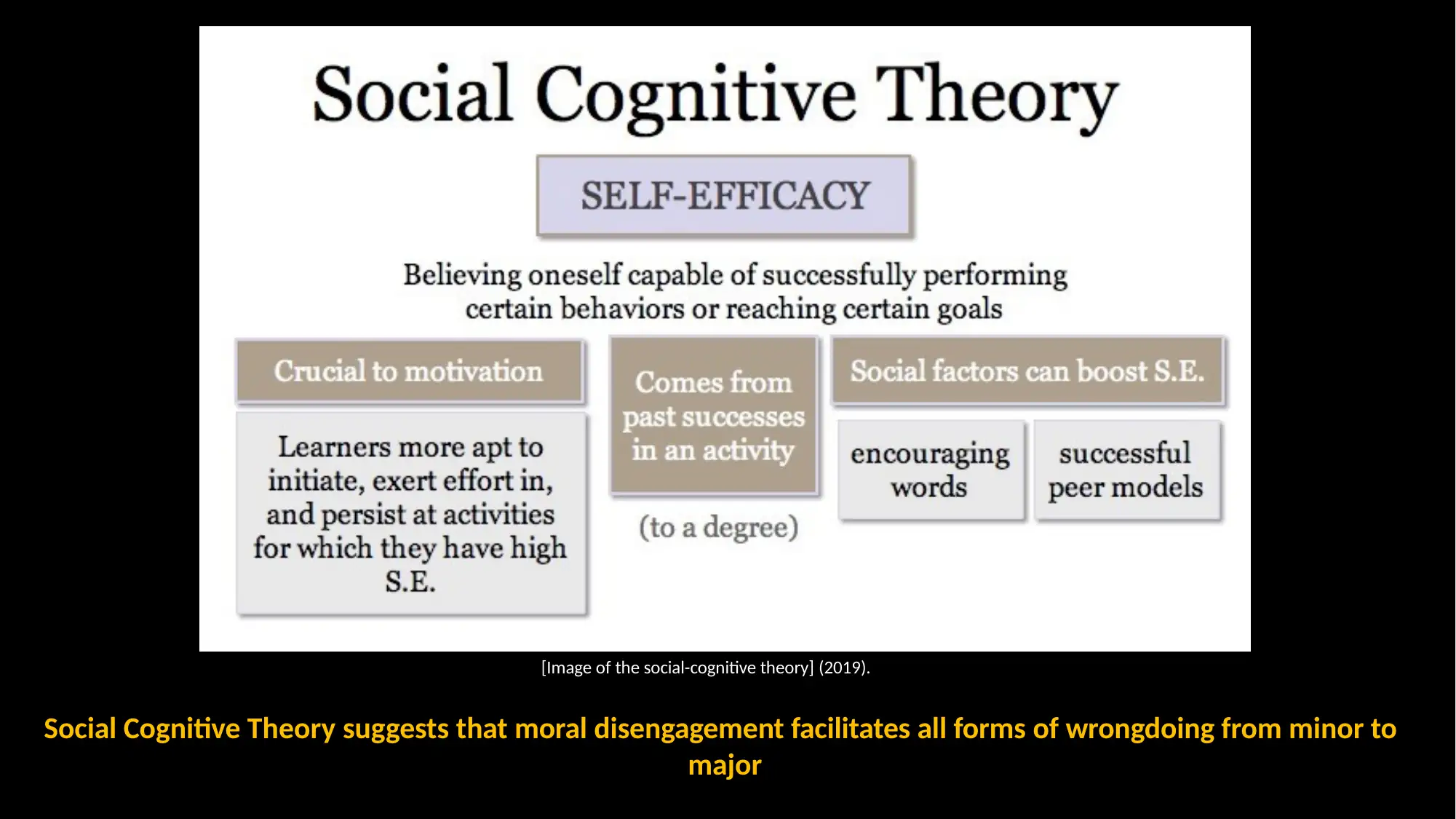
Social Cognitive Theory suggests that moral disengagement facilitates all forms of wrongdoing from minor to
major
[Image of the social-cognitive theory] (2019).
major
[Image of the social-cognitive theory] (2019).
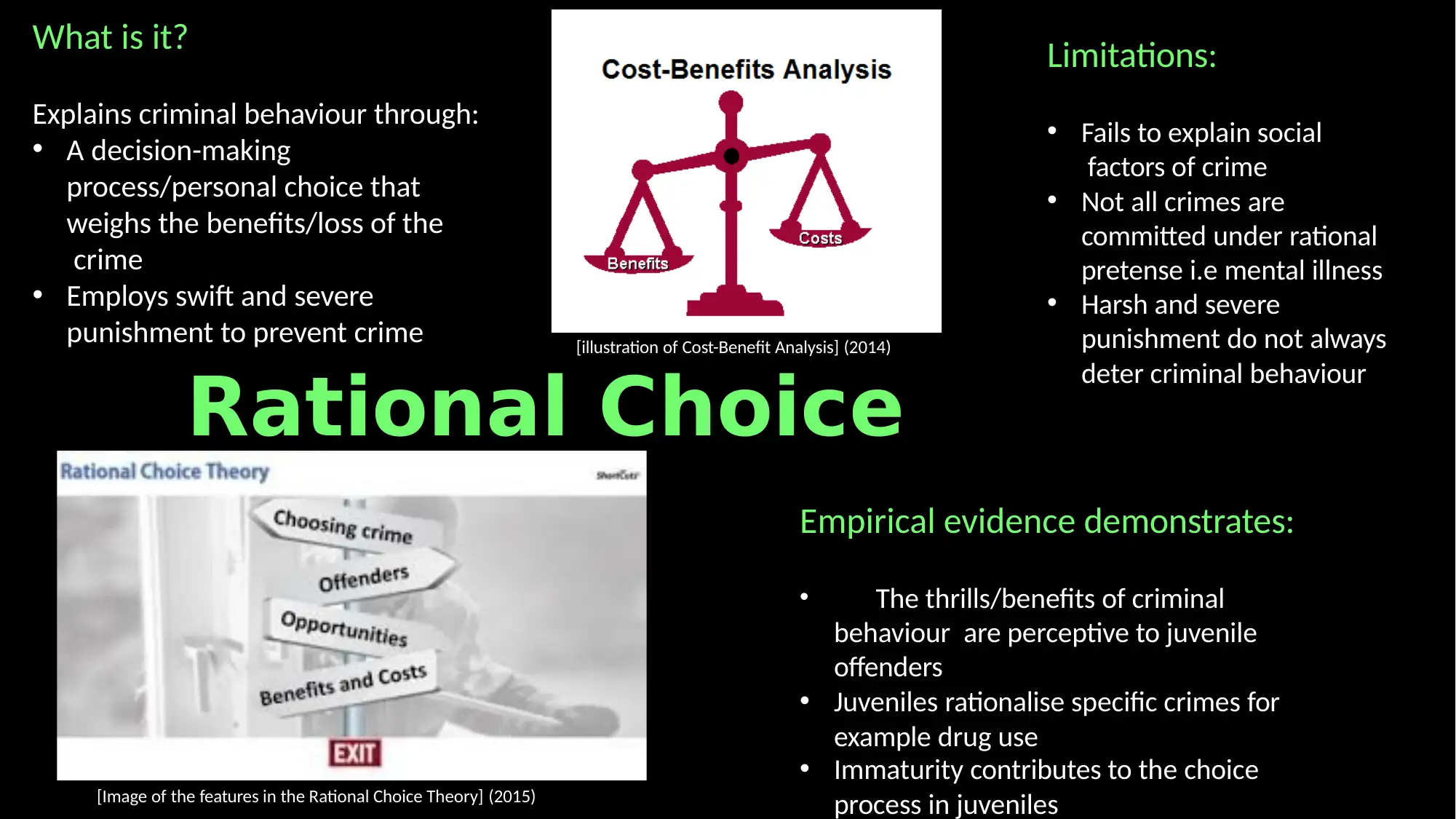
Rational Choice
Theory
What is it?
Explains criminal behaviour through:
• A decision-making
process/personal choice that
weighs the benefits/loss of the
crime
• Employs swift and severe
punishment to prevent crime
Empirical evidence demonstrates:
• The thrills/benefits of criminal
behaviour are perceptive to juvenile
offenders
• Juveniles rationalise specific crimes for
example drug use
• Immaturity contributes to the choice
process in juveniles
Limitations:
• Fails to explain social
factors of crime
• Not all crimes are
committed under rational
pretense i.e mental illness
• Harsh and severe
punishment do not always
deter criminal behaviour
[illustration of Cost-Benefit Analysis] (2014)
[Image of the features in the Rational Choice Theory] (2015)
Theory
What is it?
Explains criminal behaviour through:
• A decision-making
process/personal choice that
weighs the benefits/loss of the
crime
• Employs swift and severe
punishment to prevent crime
Empirical evidence demonstrates:
• The thrills/benefits of criminal
behaviour are perceptive to juvenile
offenders
• Juveniles rationalise specific crimes for
example drug use
• Immaturity contributes to the choice
process in juveniles
Limitations:
• Fails to explain social
factors of crime
• Not all crimes are
committed under rational
pretense i.e mental illness
• Harsh and severe
punishment do not always
deter criminal behaviour
[illustration of Cost-Benefit Analysis] (2014)
[Image of the features in the Rational Choice Theory] (2015)
⊘ This is a preview!⊘
Do you want full access?
Subscribe today to unlock all pages.

Trusted by 1+ million students worldwide
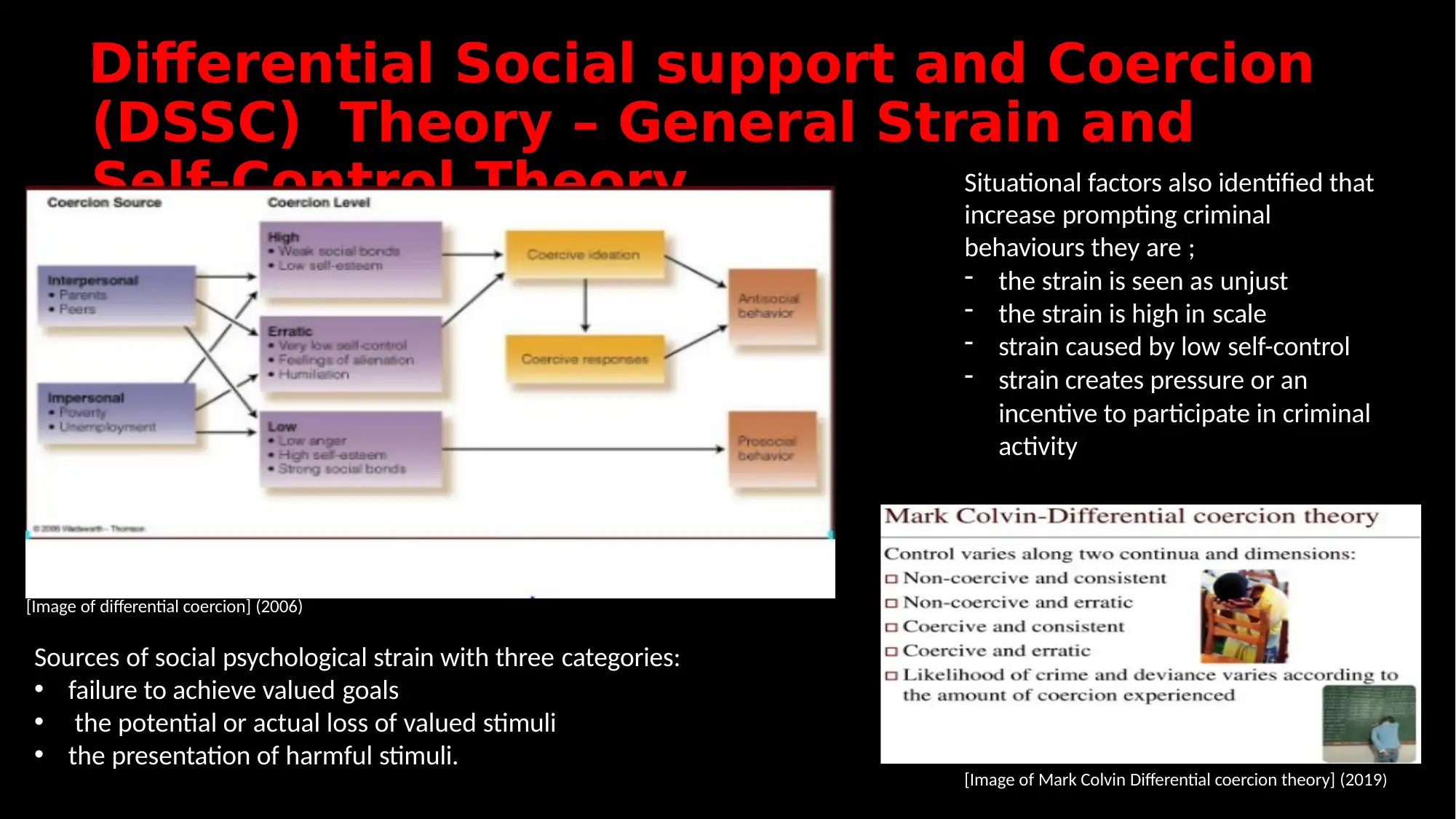
Differential Social support and Coercion
(DSSC) Theory – General Strain and
Self-Control Theory
[Image of Mark Colvin Differential coercion theory] (2019)
Sources of social psychological strain with three categories:
• failure to achieve valued goals
• the potential or actual loss of valued stimuli
• the presentation of harmful stimuli.
[Image of differential coercion] (2006)
Situational factors also identified that
increase prompting criminal
behaviours they are ;
- the strain is seen as unjust
- the strain is high in scale
- strain caused by low self-control
- strain creates pressure or an
incentive to participate in criminal
activity
(DSSC) Theory – General Strain and
Self-Control Theory
[Image of Mark Colvin Differential coercion theory] (2019)
Sources of social psychological strain with three categories:
• failure to achieve valued goals
• the potential or actual loss of valued stimuli
• the presentation of harmful stimuli.
[Image of differential coercion] (2006)
Situational factors also identified that
increase prompting criminal
behaviours they are ;
- the strain is seen as unjust
- the strain is high in scale
- strain caused by low self-control
- strain creates pressure or an
incentive to participate in criminal
activity
Paraphrase This Document
Need a fresh take? Get an instant paraphrase of this document with our AI Paraphraser
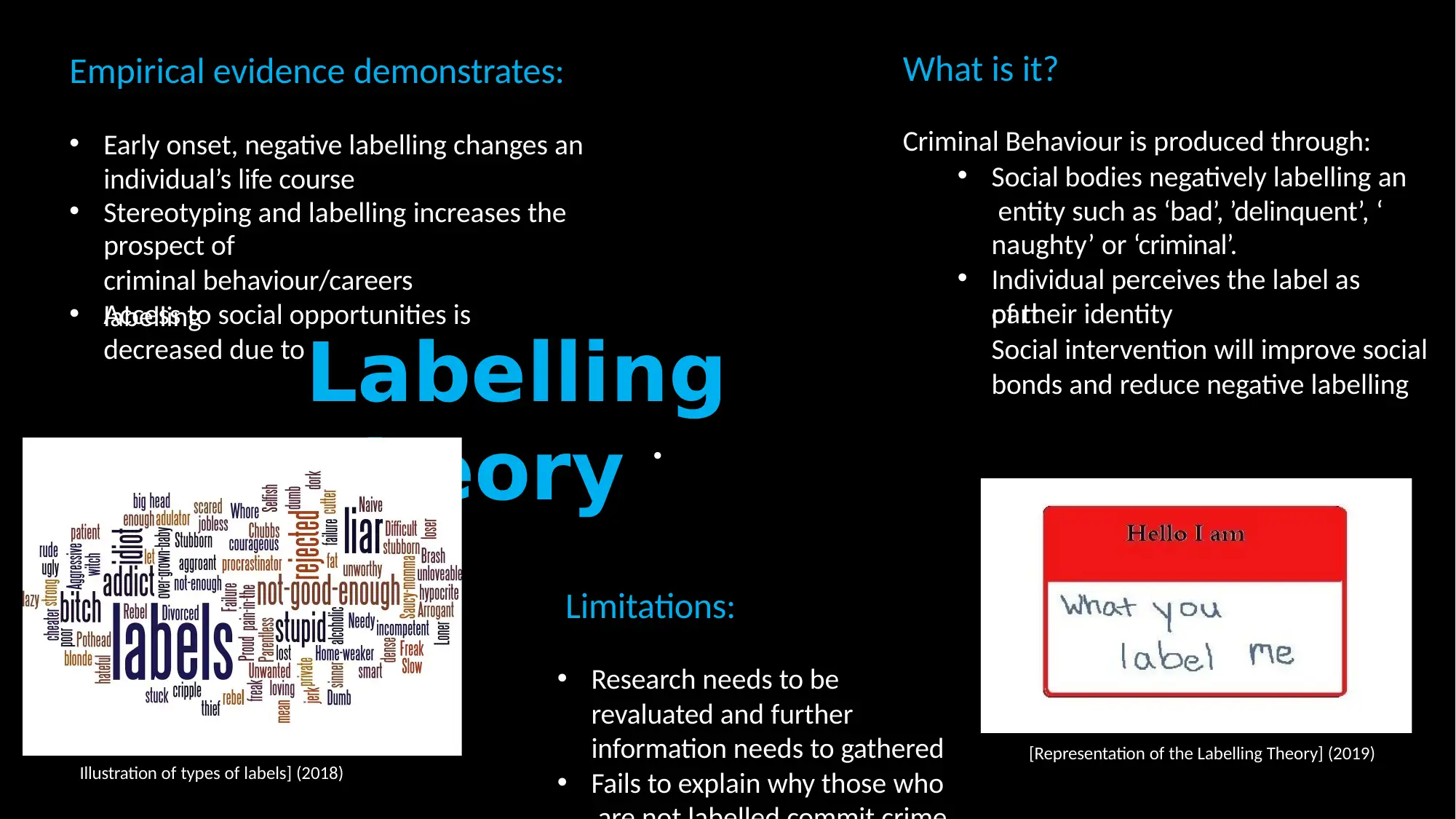
What is it?
Criminal Behaviour is produced through:
• Social bodies negatively labelling an
entity such as ‘bad’, ’delinquent’, ‘
naughty’ or ‘criminal’.
• Individual perceives the label as
partof their identity
Social intervention will improve social
bonds and reduce negative labelling
Empirical evidence demonstrates:
• Early onset, negative labelling changes an
individual’s life course
• Stereotyping and labelling increases the
prospect of
criminal behaviour/careers
• Access to social opportunities is
decreased due to
labelling
Labelling
Theory •
Limitations:
• Research needs to be
revaluated and further
information needs to gathered
• Fails to explain why those who
[Representation of the Labelling Theory] (2019)
Illustration of types of labels] (2018)
Criminal Behaviour is produced through:
• Social bodies negatively labelling an
entity such as ‘bad’, ’delinquent’, ‘
naughty’ or ‘criminal’.
• Individual perceives the label as
partof their identity
Social intervention will improve social
bonds and reduce negative labelling
Empirical evidence demonstrates:
• Early onset, negative labelling changes an
individual’s life course
• Stereotyping and labelling increases the
prospect of
criminal behaviour/careers
• Access to social opportunities is
decreased due to
labelling
Labelling
Theory •
Limitations:
• Research needs to be
revaluated and further
information needs to gathered
• Fails to explain why those who
[Representation of the Labelling Theory] (2019)
Illustration of types of labels] (2018)
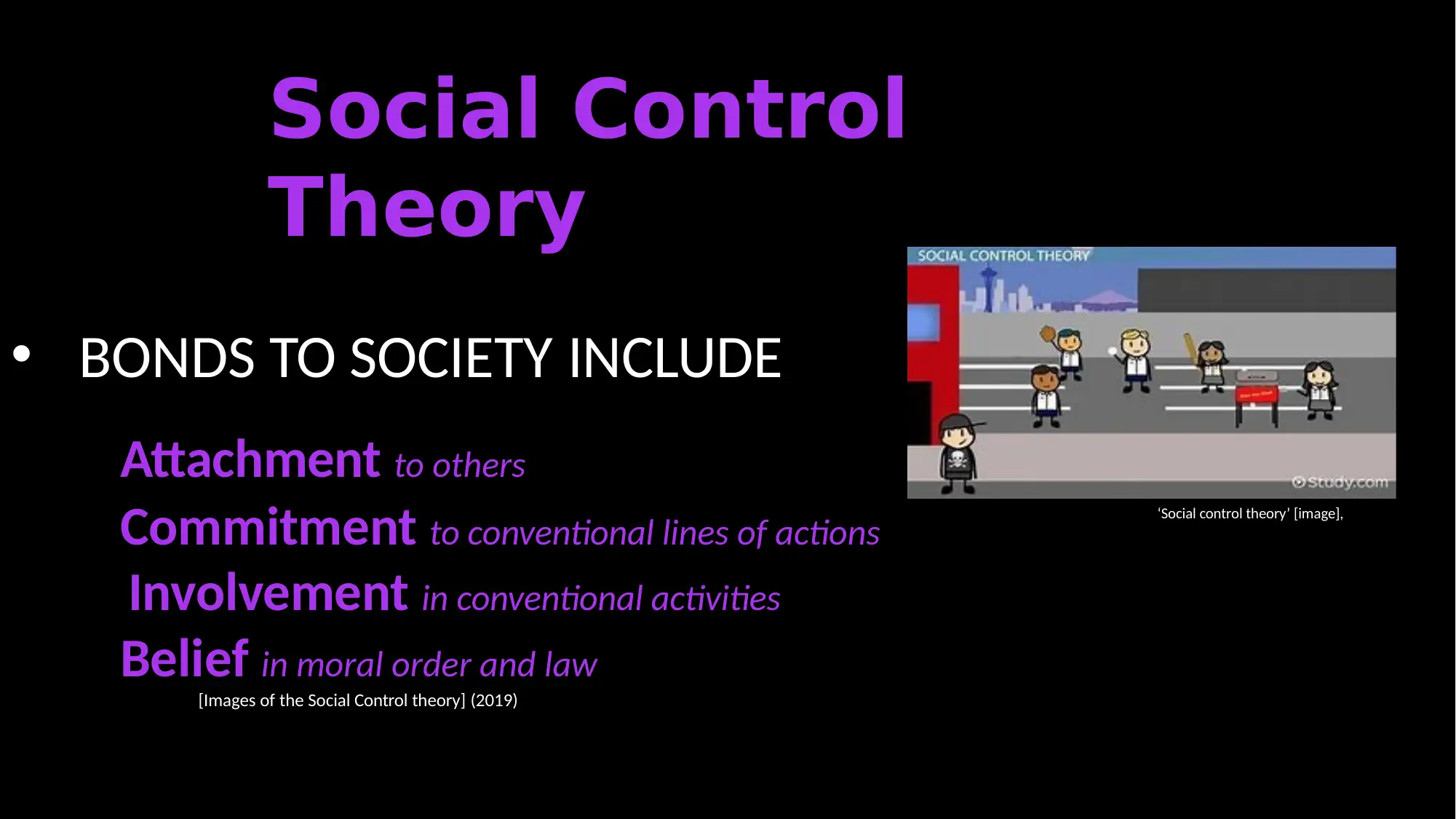
Social Control
Theory
‘Social control theory’ [image],
• BONDS TO SOCIETY INCLUDE
Attachment to others
Commitment to conventional lines of actions
Involvement in conventional activities
Belief in moral order and law
[Images of the Social Control theory] (2019)
Theory
‘Social control theory’ [image],
• BONDS TO SOCIETY INCLUDE
Attachment to others
Commitment to conventional lines of actions
Involvement in conventional activities
Belief in moral order and law
[Images of the Social Control theory] (2019)
⊘ This is a preview!⊘
Do you want full access?
Subscribe today to unlock all pages.

Trusted by 1+ million students worldwide
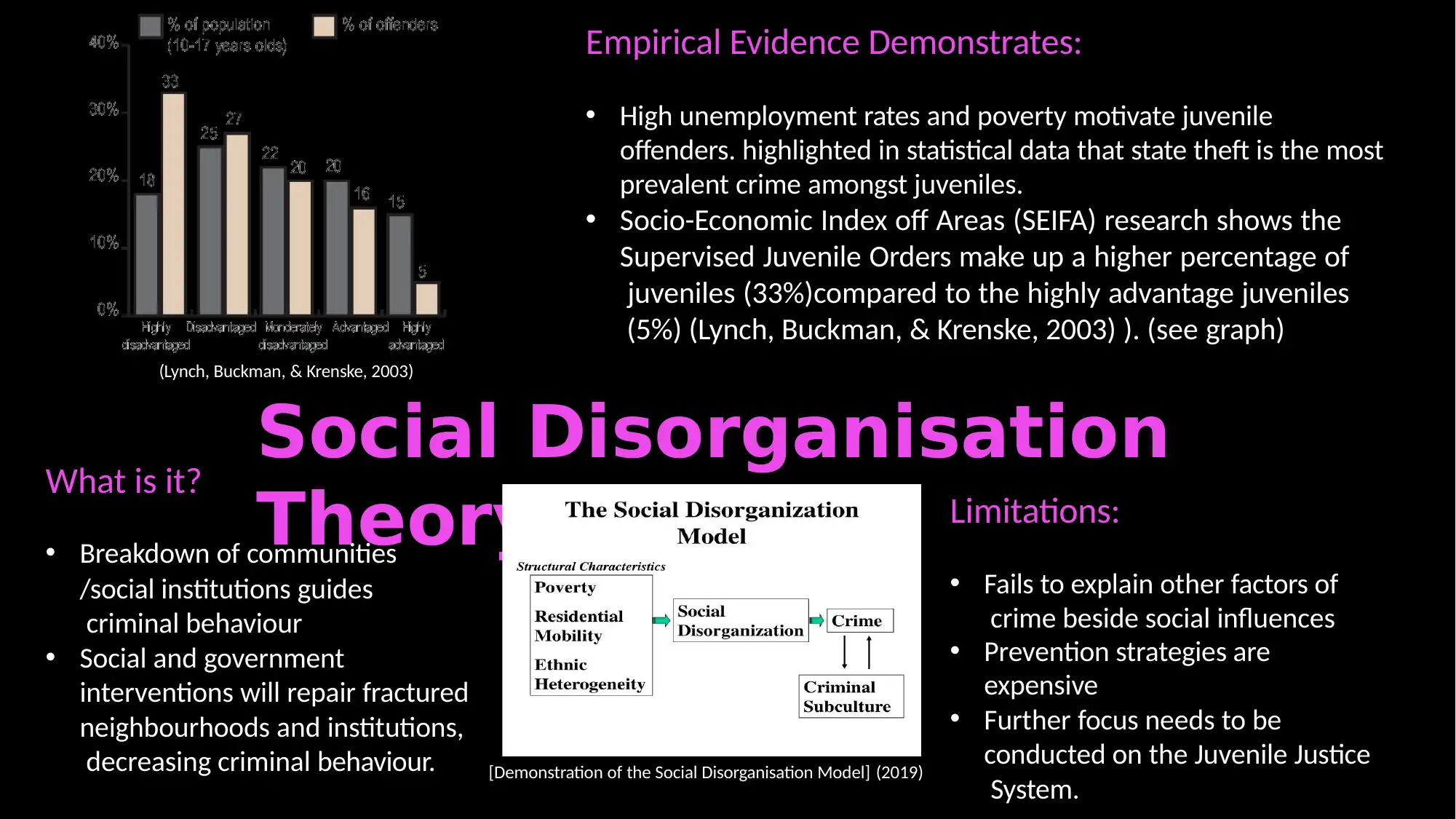
Social Disorganisation
Theory
What is it?
• Breakdown of communities
/social institutions guides
criminal behaviour
• Social and government
interventions will repair fractured
neighbourhoods and institutions,
decreasing criminal behaviour.
Empirical Evidence Demonstrates:
• High unemployment rates and poverty motivate juvenile
offenders. highlighted in statistical data that state theft is the most
prevalent crime amongst juveniles.
• Socio-Economic Index off Areas (SEIFA) research shows the
Supervised Juvenile Orders make up a higher percentage of
juveniles (33%)compared to the highly advantage juveniles
(5%) (Lynch, Buckman, & Krenske, 2003) ). (see graph)
Limitations:
• Fails to explain other factors of
crime beside social influences
• Prevention strategies are
expensive
• Further focus needs to be
conducted on the Juvenile Justice
System.
(Lynch, Buckman, & Krenske, 2003)
[Demonstration of the Social Disorganisation Model] (2019)
Theory
What is it?
• Breakdown of communities
/social institutions guides
criminal behaviour
• Social and government
interventions will repair fractured
neighbourhoods and institutions,
decreasing criminal behaviour.
Empirical Evidence Demonstrates:
• High unemployment rates and poverty motivate juvenile
offenders. highlighted in statistical data that state theft is the most
prevalent crime amongst juveniles.
• Socio-Economic Index off Areas (SEIFA) research shows the
Supervised Juvenile Orders make up a higher percentage of
juveniles (33%)compared to the highly advantage juveniles
(5%) (Lynch, Buckman, & Krenske, 2003) ). (see graph)
Limitations:
• Fails to explain other factors of
crime beside social influences
• Prevention strategies are
expensive
• Further focus needs to be
conducted on the Juvenile Justice
System.
(Lynch, Buckman, & Krenske, 2003)
[Demonstration of the Social Disorganisation Model] (2019)
Paraphrase This Document
Need a fresh take? Get an instant paraphrase of this document with our AI Paraphraser
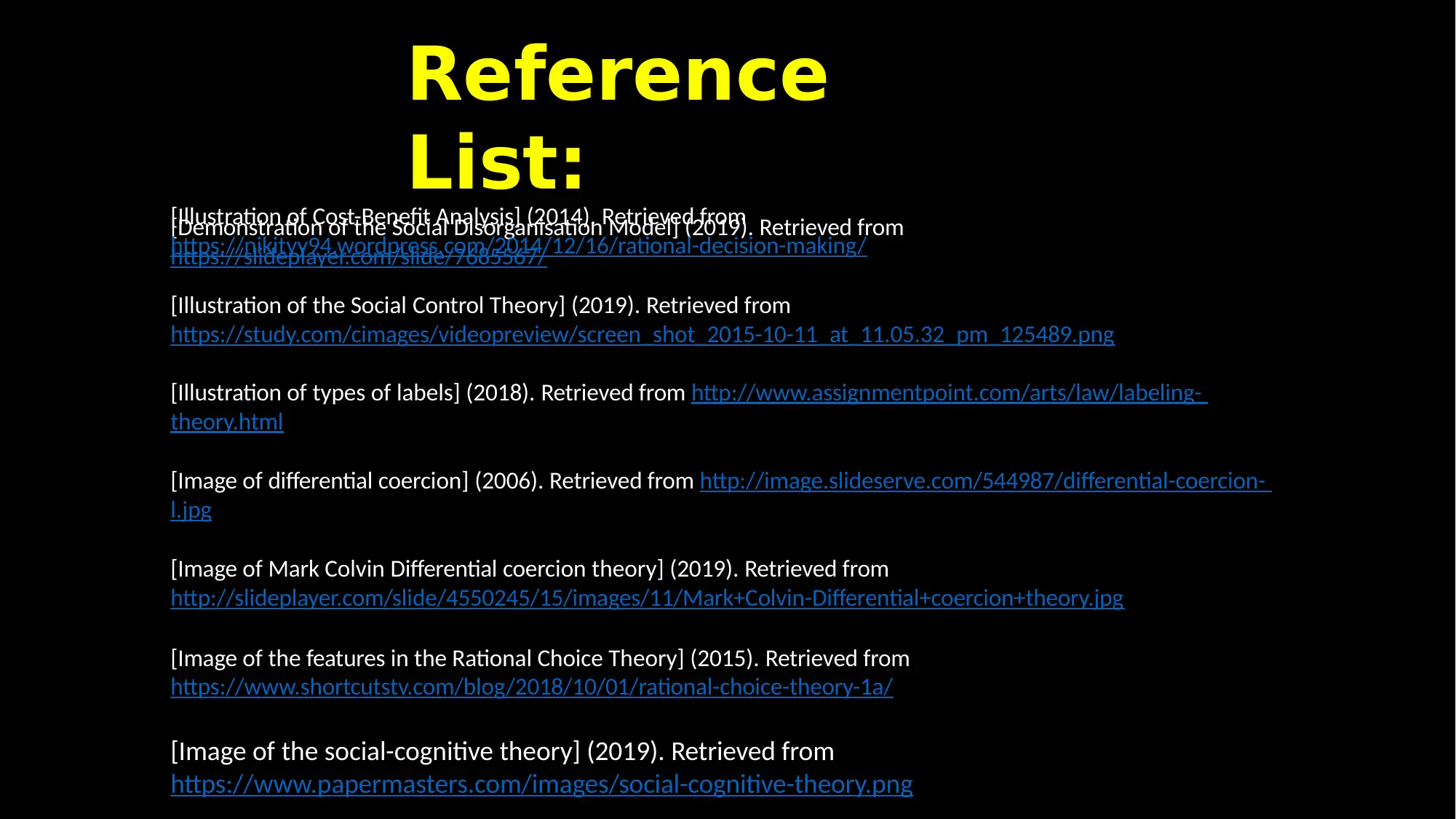
Reference
List:
[Demonstration of the Social Disorganisation Model] (2019). Retrieved from
https://slideplayer.com/slide/7685567/
[Illustration of Cost-Benefit Analysis] (2014). Retrieved from
https://nikityy94.wordpress.com/2014/12/16/rational-decision-making/
[Illustration of the Social Control Theory] (2019). Retrieved from
https://study.com/cimages/videopreview/screen_shot_2015-10-11_at_11.05.32_pm_125489.png
[Illustration of types of labels] (2018). Retrieved from http://www.assignmentpoint.com/arts/law/labeling-
theory.html
[Image of differential coercion] (2006). Retrieved from http://image.slideserve.com/544987/differential-coercion-
l.jpg
[Image of Mark Colvin Differential coercion theory] (2019). Retrieved from
http://slideplayer.com/slide/4550245/15/images/11/Mark+Colvin-Differential+coercion+theory.jpg
[Image of the features in the Rational Choice Theory] (2015). Retrieved from
https://www.shortcutstv.com/blog/2018/10/01/rational-choice-theory-1a/
[Image of the social-cognitive theory] (2019). Retrieved from
https://www.papermasters.com/images/social-cognitive-theory.png
List:
[Demonstration of the Social Disorganisation Model] (2019). Retrieved from
https://slideplayer.com/slide/7685567/
[Illustration of Cost-Benefit Analysis] (2014). Retrieved from
https://nikityy94.wordpress.com/2014/12/16/rational-decision-making/
[Illustration of the Social Control Theory] (2019). Retrieved from
https://study.com/cimages/videopreview/screen_shot_2015-10-11_at_11.05.32_pm_125489.png
[Illustration of types of labels] (2018). Retrieved from http://www.assignmentpoint.com/arts/law/labeling-
theory.html
[Image of differential coercion] (2006). Retrieved from http://image.slideserve.com/544987/differential-coercion-
l.jpg
[Image of Mark Colvin Differential coercion theory] (2019). Retrieved from
http://slideplayer.com/slide/4550245/15/images/11/Mark+Colvin-Differential+coercion+theory.jpg
[Image of the features in the Rational Choice Theory] (2015). Retrieved from
https://www.shortcutstv.com/blog/2018/10/01/rational-choice-theory-1a/
[Image of the social-cognitive theory] (2019). Retrieved from
https://www.papermasters.com/images/social-cognitive-theory.png
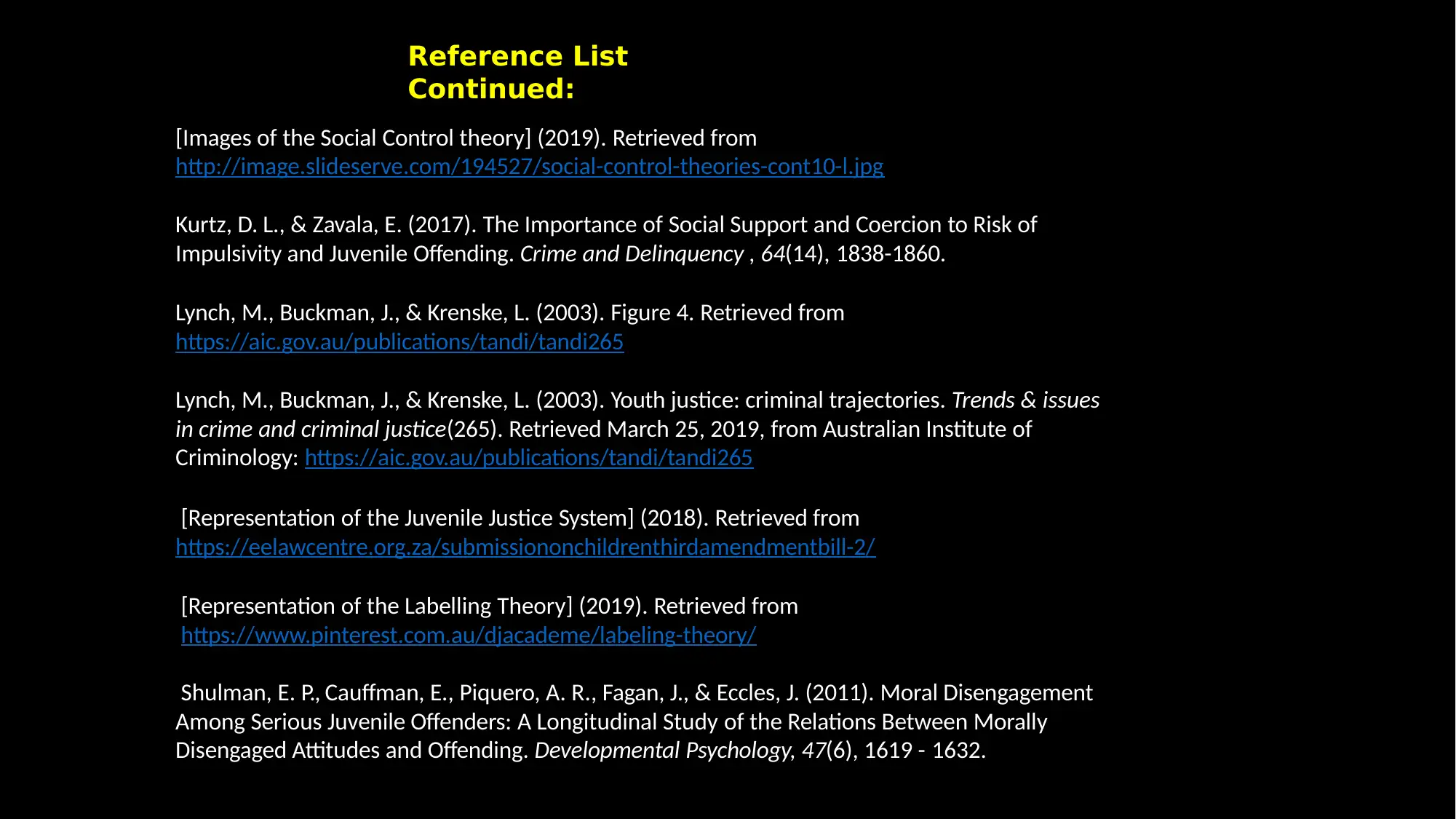
Reference List
Continued:
[Images of the Social Control theory] (2019). Retrieved from
http://image.slideserve.com/194527/social-control-theories-cont10-l.jpg
Kurtz, D. L., & Zavala, E. (2017). The Importance of Social Support and Coercion to Risk of
Impulsivity and Juvenile Offending. Crime and Delinquency , 64(14), 1838-1860.
Lynch, M., Buckman, J., & Krenske, L. (2003). Figure 4. Retrieved from
https://aic.gov.au/publications/tandi/tandi265
Lynch, M., Buckman, J., & Krenske, L. (2003). Youth justice: criminal trajectories. Trends & issues
in crime and criminal justice(265). Retrieved March 25, 2019, from Australian Institute of
Criminology: https://aic.gov.au/publications/tandi/tandi265
[Representation of the Juvenile Justice System] (2018). Retrieved from
https://eelawcentre.org.za/submissiononchildrenthirdamendmentbill-2/
[Representation of the Labelling Theory] (2019). Retrieved from
https://www.pinterest.com.au/djacademe/labeling-theory/
Shulman, E. P., Cauffman, E., Piquero, A. R., Fagan, J., & Eccles, J. (2011). Moral Disengagement
Among Serious Juvenile Offenders: A Longitudinal Study of the Relations Between Morally
Disengaged Attitudes and Offending. Developmental Psychology, 47(6), 1619 - 1632.
Continued:
[Images of the Social Control theory] (2019). Retrieved from
http://image.slideserve.com/194527/social-control-theories-cont10-l.jpg
Kurtz, D. L., & Zavala, E. (2017). The Importance of Social Support and Coercion to Risk of
Impulsivity and Juvenile Offending. Crime and Delinquency , 64(14), 1838-1860.
Lynch, M., Buckman, J., & Krenske, L. (2003). Figure 4. Retrieved from
https://aic.gov.au/publications/tandi/tandi265
Lynch, M., Buckman, J., & Krenske, L. (2003). Youth justice: criminal trajectories. Trends & issues
in crime and criminal justice(265). Retrieved March 25, 2019, from Australian Institute of
Criminology: https://aic.gov.au/publications/tandi/tandi265
[Representation of the Juvenile Justice System] (2018). Retrieved from
https://eelawcentre.org.za/submissiononchildrenthirdamendmentbill-2/
[Representation of the Labelling Theory] (2019). Retrieved from
https://www.pinterest.com.au/djacademe/labeling-theory/
Shulman, E. P., Cauffman, E., Piquero, A. R., Fagan, J., & Eccles, J. (2011). Moral Disengagement
Among Serious Juvenile Offenders: A Longitudinal Study of the Relations Between Morally
Disengaged Attitudes and Offending. Developmental Psychology, 47(6), 1619 - 1632.
⊘ This is a preview!⊘
Do you want full access?
Subscribe today to unlock all pages.

Trusted by 1+ million students worldwide
1 out of 9
Your All-in-One AI-Powered Toolkit for Academic Success.
+13062052269
info@desklib.com
Available 24*7 on WhatsApp / Email
![[object Object]](/_next/static/media/star-bottom.7253800d.svg)
Unlock your academic potential
Copyright © 2020–2025 A2Z Services. All Rights Reserved. Developed and managed by ZUCOL.


